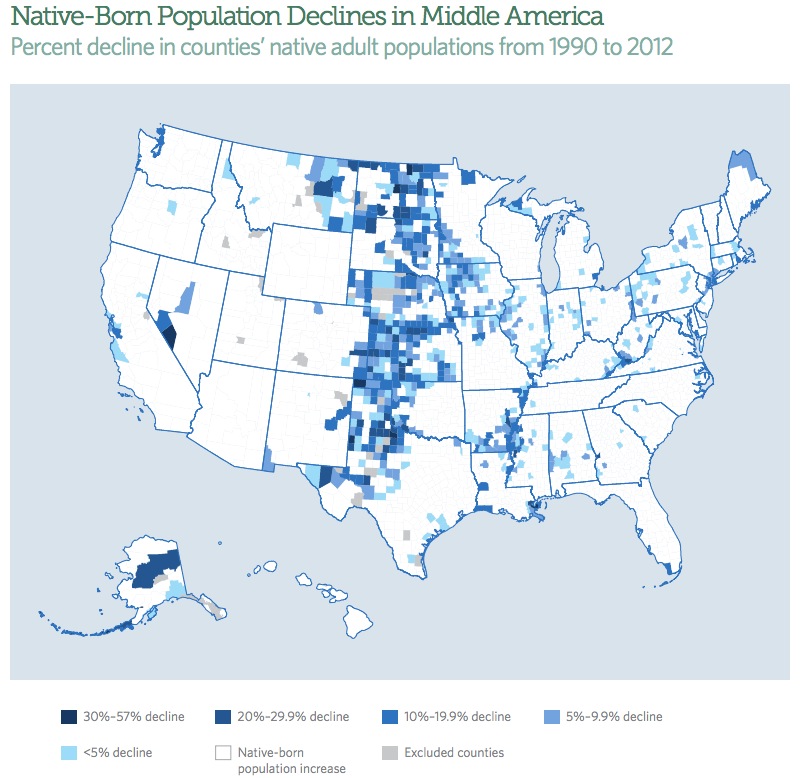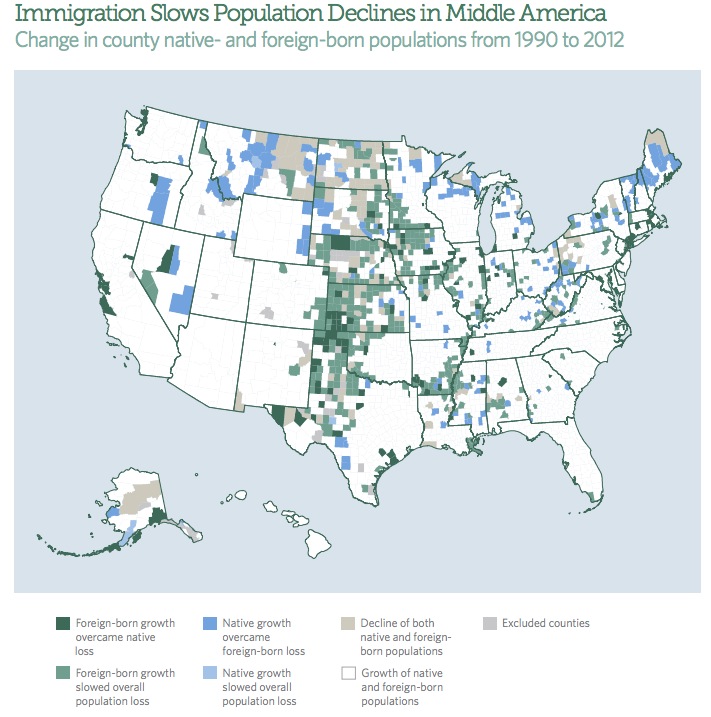The obvious solution to South Dakota's vo-tech workforce shortage is higher wages. But if our business and political leaders are committed to ignoring that option, perhaps we can consider another solution: immigrants.
The Pew Charitable Trusts just issued a report on "Changing Patterns in U.S. Immigration and Population." It includes this map of counties where the population of U.S.-born residents has declined over the last couple decades:

See that big blue band down the middle of the country? Those are counties where there are fewer natives born Americans. More of East River is emptying out than West River.
A lot of counties in that band of demographic blues are countering that population loss with immigrants:

The dark green counties saw foreign immigration growth outpace the native population loss. The lighter green counties saw foreign immigration slow their shrinkage. Notice that green starts to peter out around the Dakotas.
South Dakotans, like all Americans, are getting older and having fewer babies. The Pew report says immigration is key to filling the workforce:
In addition to having the potential to offset population decline in some areas of the country, immigrants can also compensate for the aging of the native-born population. The median age of the total U.S. population is rising, and the ratio of seniors (ages 65+) to working age people (ages 25-64) is increasing. Immigration mitigates these trends by adding working age adults to the U.S. population. Nearly half of immigrants admitted between 2003 and 2012 were between the ages of 20 and 40, while only 5 percent were ages 65 or older.
The size and makeup of the U.S. population has important implications for economic productivity, taxation, and spending. Immigrants are already disproportionately represented in the labor force with a share of about 16 percent, while they make up about 13 percent of the overall population. The Pew Research Center has determined that if current immigration trends and birth rates continue, by 2050 virtually all (93 percent) of the nation’s working age population growth will come from immigrants and their U.S.-born children [Pew Charitable Trusts, "Changing Patterns in U.S. Immigration and Population: Immigrants Slow Population Decline in Many Counties," December 2014].
South Dakota has shown its willingness to use immigration as an economic development tool in the past. The state appears to recognize at least part of the immigration–economics equation in its new Build Dakota vo-tech scholarship program:
But with high school graduation classes declining, South Dakota also must lure more people here from other states. Build Dakota understands that, its designers say. Out-of-staters entering one of South Dakota’s four technical schools will be able to apply for full scholarships, too, as long as they commit to working at least three years in the state after they graduate [Steve Young, "Build Dakota Offers Promise for Workforce Growth," that Sioux Falls paper, 2014.12.19].
But notice the limits there: we're thinking about students from other states, not workers from other countries. We're targeting youth who will in a couple years turn into technicians who will work for three years with entry-level skills at entry-level wages. Where's the component of our economic development plan that targets experienced workers, foreign and domestic, who could come to South Dakota and add value right now with better skills and bigger families?
Our workforce shortage is not magic. South Dakota has more retirees, fewer workers, and fewer kids stepping in to replace them. Our workforce recruitment efforts need to do more to ride the immigration wave that is boosting other parts of Middle America.

The bottom line key to addressing South Dakota's employment woes is increasing wages. Cash in the billfold trumps every other factor, just look at the ND oil fields. People will do without a lot if they are adequately paid.
And if you want experienced workers it'll take more cash. Someone at the midpoint in their career commands more money than someone starting out. Experience has a value and it rightfully commands a premium.
This certainly provides proof that immigrants from other countries and their children are not taking jobs away from anyone.
There is a population to take into consideration, in particular with changes in the legal system regarding teens/young adults, and those arrested for marijuana possession. Everyone of them will be released from the legal system, and many of them need guidance, support, or whatever it is called, to get onto the right track.
It seems that for now when people are released from prison, they receive a pittance amount of money, then told to fly on their own. They end up relying on social service programs, for which there is not enough of, or on the streets, or eventually back in prison.
With tight supply one might expect that South Dakota workers would be among the highest paid in the US. Clearly the law of "supply and demand" does not work for regular folk.
A major league shortstop who can hit 40 homers a season along with brilliant fielding and stolen base speed can make $30,000,000 or more a year. But then that player won't be working in South Dakota either. And he is currently living in Cuba.
Pay shortage = worker shortage, no rocket science here. Work force development is about using tax payer dollars to create a worker surplus, really just subsidizing employers.
Yet we have massive unemployment on the reservations.
John, you are right! The thinking coming out of the Governor's office is confusing given his ideology. Especially the part about going against Milton Friedman and thinking that the government can create jobs.
Think how many jobs would be created by fixing our infrastructure, roads and bridges rather than pushing it off for future generations.
What can be done?
No one can force business owners to pay more beyond the legal requirement.
How do we force any of the businesses on Phillips Avenue, Sioux Falls, to pay their employees more?
Do we tell the owner of Zandbroz to increase what they pay their employees by increasing the price of their goods? Would increasing the price of their goods mean that they will have more, fewer, or about the same number of customers buying their goods?
Please note that I am not picking on Zandbroz because I have no clue as to what they pay, I am using Zandbroz purely as an example to put a face on the discussion.
If business owners have to reduce their profits to the point that they cannot pay their business and personal expenses, they will not be able to stay in business very long.
Right now there does not seem to be much interest of major companies moving to SD in spite of the so-called business friendly status the SD is suppose to have. How can we convince Ford (vehicles) to open up a factory in SD?
How do we convince a medical supply manufacturer, or distribution center, to open in SD where there are two hospitals that are thriving?
Nick points rightly to the lesson of the Bakken. Pay more, and people will move, even to rotten places like the North Dakota tundra.
Mike, good reminder about another complication in our workforce problem. Alongside a major push to draw foreign immigration, I'd love to advocate every Build Dakota scholarship go to an American Indian student. Among the problems there, though, is that cultural pressures keep many Indians from leaving the reservations. A large migration of workers from the reservations to South Dakota's job centers may not be feasible or desirable. Maybe we need to build a vo-techs on Pine Ridge and Standing Rock... right next door to giant state-funded industry development centers?
Statehood for the tribes, Mexico and Cuba.
i've always thought consensual annexation of Mexico would solve both the drug problem and the immigration problem, USA can provide infrastructure and government which we could be good at, tourism would go off the charts and the additional natural resources and taxpayers "south of the border" would keep us all going another hundred years.
No one wants to move to the anti-gay, anti-living wage, anti-progressive, anti-Native American, anti-immigrant, anti-unions, and anti-teacher frozen tundra that is South Dakota.
Until SD elects a Dem governor and has majoritrrity ruleule in Pierre, low wages are here to stay.
The last republican governor to even admit SD wages were too low and wanted to do something about it was Governor Mickelson and that was 25 years ago. SD, for now is stuck with an anti-teacher governor that is still sulking from teachers not supporting his teacher bill from two years ago.
SD Dems do not have a voice in Pierre on the low wage issue, so repressed wages will continue to be a way of life for many South Dakotans because Republican leadership does not care.
Here is what we have here in South Dakota. It is long past time for the powers to be in the state to do something about it rather than window dressing. Higher wages would mean more and better jobs for the state that would lift all. Here is the sordid state of affairs for women trying to raise families here.
"Women in all racial and ethnic groups experienced higher
poverty rates than white, non-Hispanic men. Poverty rates
were particularly high, at about one in four, among black
(25.1 percent) and Hispanic (24.8 percent) women, and
about one in three among Native American (34.4 percent)
women. Rates for foreign-born women (20.0 percent),
white, non-Hispanic women (10.3 percent), and Asian
women (11.5 percent) were also considerably higher than
the rate for white, non-Hispanic men (7.7 percent).
Poverty rates for all groups of adult women were higher
than for their male counterparts (see Table 1)." http://www.nwlc.org/sites/default/files/pdfs/final_2013_nwlc_povertyreport.pdf
Take a look at the condition of Native women. As long as South Dakota keeps wages low with the kind of gimmicks this one is, we will all see the same sad results. Higher wages for the jobs at hand. When the tourism industry can bring in workers at slave wages each and every year, what does that say about the seriousness of the Daugaard cabal. When big ag does the same with illegal's, what does that say as well?
The saddest part of all this is the number of SD voters that STILL believe that if wages are raised that they will lose their jobs and that SD is too poor to take care of its own. It's not how much $ we have, it's what is being done with it. Rounds/Daugaard thought it was ok to give $69m to the XL Keystone pipelines but tell us we can't raise wages, fund education, fix our roads, make college affordable or expand Medicaid. Yet, even after all the corruption became apparent, they both can get a majority of votes to have both of them continue to represent us. It baffles me.
f*ckin republicans: headlines today-"giuliani says obama... incites anti-police hatred." meanwhile 1billion votes, 31 cases of voter fraud. vox.com
Remember leslie, this buffoon, giuliani, denied his first responders the necessary communications systems to communicate with one another on 9/11. He is not responsible for the attack, but he is responsible for many unneeded deaths that happened because of his direct failure. Both he and his felonious chief of police, Bernie Kerik, should have shared a cell. The only thing the republicans really have to make all of this white noise, are these two crooks. Think of that for a minute, these two bozo heads are the talking heads of the republican party, life is funny. http://www.nydailynews.com/new-york/nypd-boss-bernard-kerik-prison-article-1.1356234 s